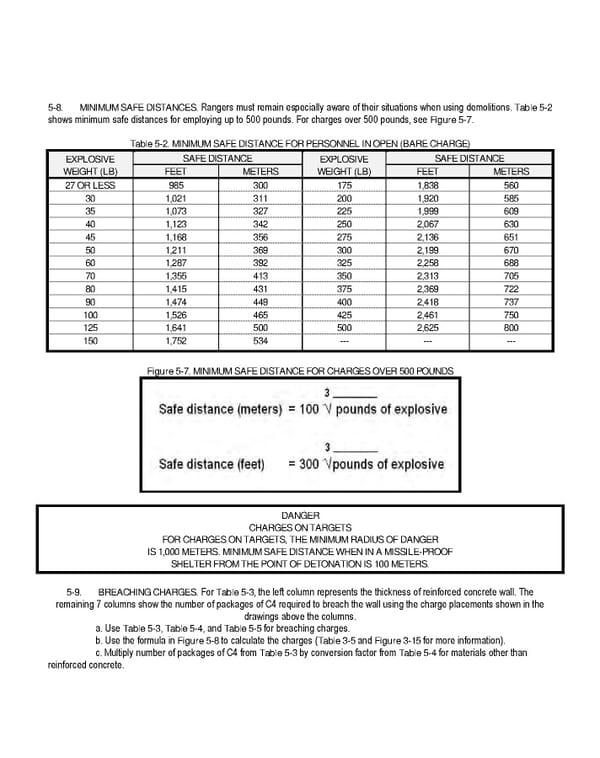5-8. MINIMUM SAFE DISTANCES. Rangers must remain especially aware of their situations when using demolitions. Table 5-2 shows minimum safe distances for employing up to 500 pounds. For charges over 500 pounds, see Figure 5-7. Table 5-2. MINIMUM SAFE DISTANCE FOR PERSONNEL IN OPEN (BARE CHARGE) EXPLOSIVE WEIGHT (LB) SAFE DISTANCE EXPLOSIVE WEIGHT (LB) SAFE DISTANCE FEET METERS FEET METERS 27 OR LESS 985 300 175 1,838 560 30 1,021 311 200 1,920 585 35 1,073 327 225 1,999 609 40 1,123 342 250 2,067 630 45 1,168 356 275 2,136 651 50 1,211 369 300 2,199 670 60 1,287 392 325 2,258 688 70 1,355 413 350 2,313 705 80 1,415 431 375 2,369 722 90 1,474 449 400 2,418 737 100 1,526 465 425 2,461 750 125 1,641 500 500 2,625 800 150 1,752 534 --- --- --- Figure 5-7. MINIMUM SAFE DISTANCE FOR CHARGES OVER 500 POUNDS DANGER CHARGES ON TARGETS FOR CHARGES ON TARGETS, THE MINIMUM RADIUS OF DANGER IS 1,000 METERS. MINIMUM SAFE DISTANCE WHEN IN A MISSILE-PROOF SHELTER FROM THE POINT OF DETONATION IS 100 METERS. 5-9. BREACHING CHARGES. For Table 5-3, the left column represents the thickness of reinforced concrete wall. The remaining 7 columns show the number of packages of C4 required to breach the wall using the charge placements shown in the drawings above the columns. a. Use Table 5-3, Table 5-4, and Table 5-5 for breaching charges. b. Use the formula in Figure 5-8 to calculate the charges (Table 3-5 and Figure 3-15 for more information). c. Multiply number of packages of C4 from Table 5-3 by conversion factor from Table 5-4 for materials other than reinforced concrete.
 Ranger Handbook Page 91 Page 93
Ranger Handbook Page 91 Page 93